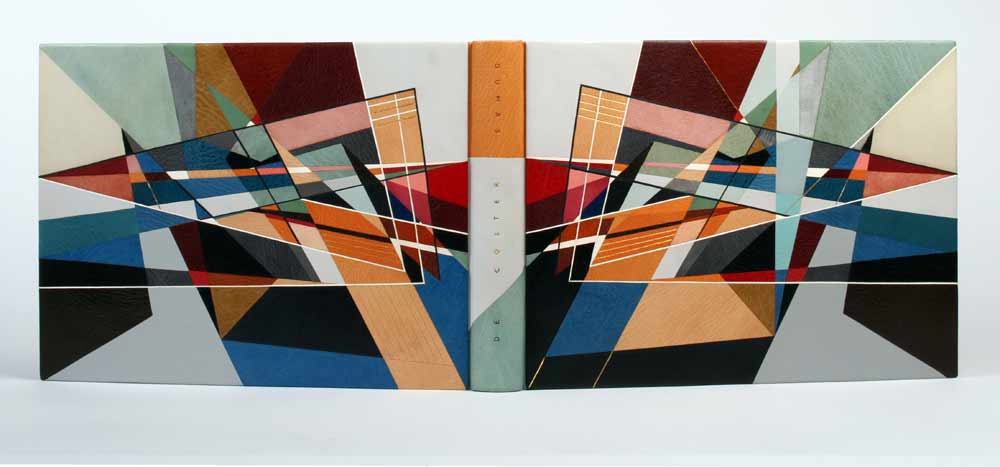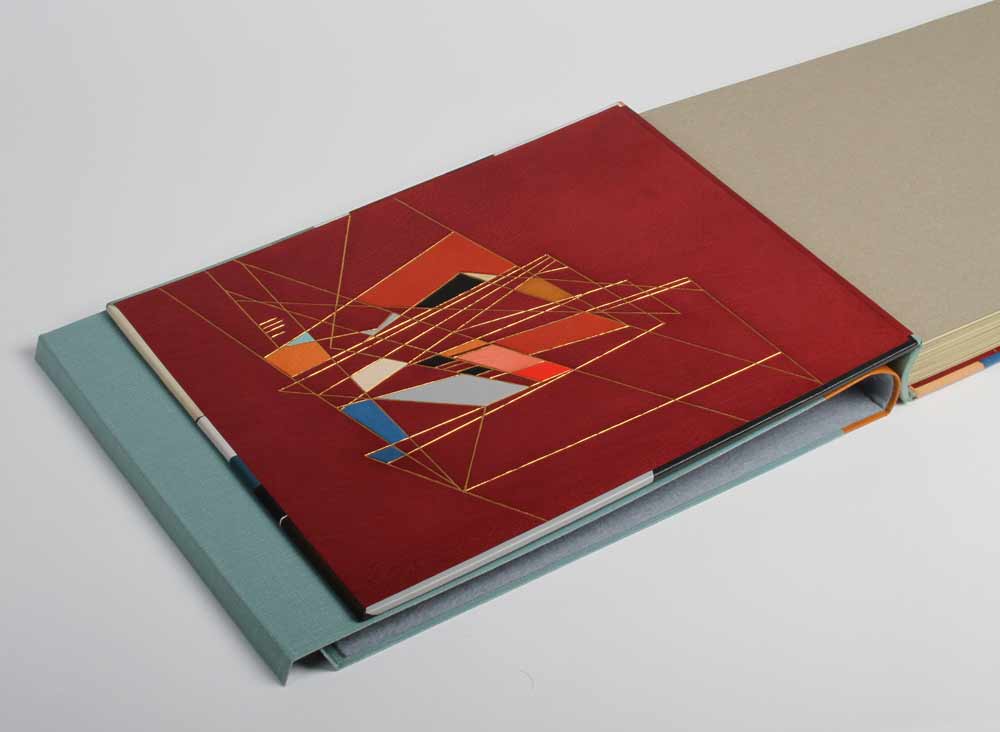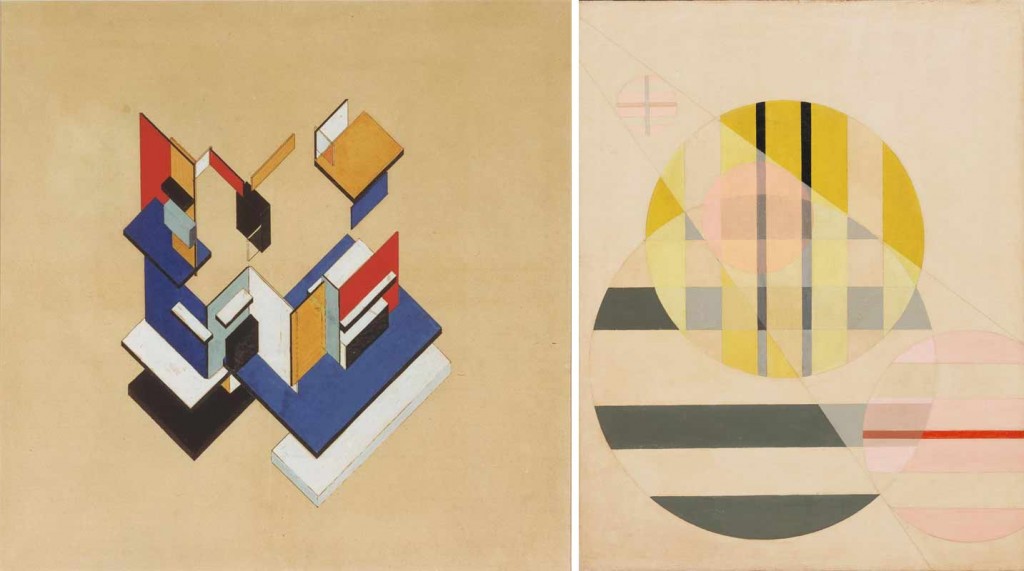Dumas/de Coster is a beautiful collection of photographs of bookbindings from 1935-1980. It was published in a limited edition of 100 in Paris for the Librarie Auguste Blaizot in 1981. The catalogue is printed on tinted Romana paper, with 14 color and 19 black and white photographs, signed by both artists.
Commissioned by a collector, Derek Hood bound this book as a laced-in boards binding sewn on pleister tapes. (I’m not familiar with this term, but Derek describes them as the French type that you can then fray and lace into the boards after sewing.) The individual pages were guarded before sewing. The spine was covered in three separate parts and the boards were attached using the leather over boards technique (also referred to as a Bradel binding), once completed. The top edge is hand gilt in 24kt leaf and the headbands sewn with silk thread.
The endpapers are leather jointed with leather doublures, which are decorated with onlays and gold tooling in a similar manner as the cover design. The book is housed in a quarter leather chemise and a leather entry slipcase.
I always look forward to the moment when my inbox receives material for the next interview. As I opened the folder containing images of Derek Hood’s more recent bindings I was struck by the image of this binding. I’m greatly inspired by Derek’s work and was so pleased he agreed to be interviewed on my blog.
The design of this binding is incredibly complex. The linear and triangular forms along with the range of colors offers intrigue and depth. Derek shares his inspiration and process behind the design.
The design was abstracted from a pencil landscape drawing by Germaine de Coster. Initially, the whole image was traced in simplistic linear form, outlining the buildings, mountains and sunrays, so that every pencil stroke was essentially accounted for. Areas of interest were then honed and focused on until the main triangular form was realized. The finished piece has only an essence of the original drawing, but it is intended to convey the same idea of sunlight and shadow bouncing off multiple planes whilst crossing a vast landscape.
In 2006, Derek was elected a Licentiate member of the Designer Bookbinders and assigned Paul Delrue and Lori Sauer as mentors. Derek never formally visited either of them during his licentiateship, but discussed the topics of art and books regularly on the telephone. “I like them and their work a lot. It was nice to have two strong, but totally different perspectives on life within the realms of Designer Bookbinders.” Derek now holds the position of a Fellow in the Designer Bookbinders.
Read the interview after the jump and come back each Sunday in the month of April for more of Derek’s work.
You studied Bookbinding and Printing at Napier College in Edinburgh, Scotland from 1982-86. Can you discuss why you choose this area of study and what your training was like? Who did you receive your training from?
The course in Edinburgh was a City and Guilds 518/2 specialising in hand bookbinding and incorporating printing and publishing. I chose to do it because it encompassed all areas of book production. It was spread over 4 years, the first year being full time. The printing and Art department at the college were fantastic; I learned all aspects of printing, typesetting and bookbinding. Everything from hand tooling to four-colour offset printing was included. My tutor there was Arthur Currie; one of the original binders to be commissioned by Colin Hamilton and Kulgin Duval for their collection of design bindings in 1975. He was a great binder/tutor and primary introduction for me into the world of design led bookbinding. After seeing some of his work, I knew this would become something more than just an interest. After finishing college, phototypesetting and digital printing were on the rise, so I never had the opportunity to put any of my newfound print skills and knowledge to use. Sadly, the year after I completed the course, it was closed down.
During your apprenticeship at the University of St. Andrews Library bindery, was your work more conservation based?
I worked at St. Andrews University for about five years as a hand bookbinder, which did help me to hone the skills that I had absorbed at Napier. My apprenticeship mainly concentrated on periodical binding and restoring much of the Library’s extensive collection. I was never formally taught conservation, although aspects of it would always creep into the daily workload including paper repair, washing and resizing. It is one area of study, if I ever found time, that I would like to enhance. I really loved my time working at the Library, as you never knew what was going to be next in your workload. I remember once making new vellum ties for a pair of books found in a Monastery in the 15th Century. The next day, by contrast, I could be lettering 50 cloth cases.
You spent 10 years of your life working as a professional musician, what drew you back to bookbinding?
I was always involved with bands while studying at college, and later while working at the library, so an inevitable point of conflict was reached between the two when music became more time consuming and I made the choice to leave my job. I did however make the conscious decision to return to bookbinding later in life and tried my best to keep interested and informed whenever I could. My life as a musician was great- I was lucky to have the experiences I had. From recording live TV in Paris to recording in Abbey Road, I had a wonderful time. But there comes a point at which your head and your heart stop appreciating it and after spending 10 years touring, recording and banging drums, I work in a nice and quiet studio now.
The designs on your fine bindings are quite classic, reminding me of Edgar Mansfield and Ivor Robinson. Do you have any major influences in or out of the binding community?
While working at St. Andrews, most of my music playing and socialising was spent in Dundee in, and around, the Art College. In 1982 there was an active revival at the college of the Destijl Movement, which led me to discover the work of Theo van Doesburg and László Moholy-Nagy amongst others. At the age of 19, I remember seeing Theo Van Doesburg’s ‘The Cow’ abstracted in four stages. The way that the four images were broken down into basic parts and stripped of their objective nature appealed to me greatly and was to have a big influence on how I was to think and work creatively from then on.
Bookbinding wise, I would take any comparison to Ivor and Edgar’s work as a very kind compliment. Although not directly influenced by them, they are definitely two binders who’s work I greatly admire. I visited Ivor some years ago and he took me through his archive of beautiful binding designs. I also have some of his handle letters, which I use regularly and look after.
Jeff Clements is another binder whose early work I really like and has similar artistic leanings to myself.
After working as a binder/designer for Sangorski & Sutcliffe in London and Bayntun Riviere in Bath for more than a decade, you set up your own business. Can you talk about your studio space and the work you take on.
My new studio is in the surrounds of the Bath Artists Studios. Over the years I had built up a reasonable amount of binding equipment and needed to find a proper workspace to accommodate it. The BAS ticked all the boxes and is a great place to be. I now work solely to commission on fine binding projects. From the outset, I made the decision not to take on work to pay the rent e.g. cloth/leather repairs or thesis work. I know too many people who take on large studios and have to meet the bills with cloth casework and repairs and ironically then end up having no time for design binding. I don’t want to fall into that trap. At the moment I am about to start working on a commission to commemorate the opening of the New Birmingham Library. I am really looking forward to this project as I have commissioned a jeweller to produce some large silverwork panels that will be incorporated into the front and backboards. The book is an early copy of Aesop’s Fables published in 1657.




